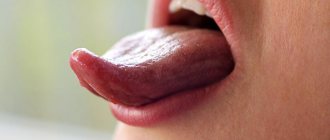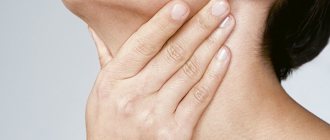The state of the tongue reflects the state of the human body. That is why almost any doctor during an examination asks the patient to show his tongue. In a healthy person, the tongue has a pale pink color, pronounced papillae, and a straight fold exactly in the center. It should be soft to the touch, and moving it should not cause discomfort or pain. If you find that you have a white tongue, then there is a high probability of certain problems in the body. In this article we will talk about how dangerous the appearance of plaque on the tongue is, what causes and diseases lead to changes in the condition of the organ, and how this problem can be avoided and eliminated.
Anatomy: what does the tongue consist of?
The tongue is an organ that is part of the digestive system. It performs several functions:
- plays an important role in the formation of speech;
- helps form a bolus of food in the mouth and push it into the esophagus;
- helps us determine the taste of food.
What does language consist of? The organ is conventionally divided into two parts:
- the body of the tongue is the anterior movable part;
- The root of the tongue is the back part located closer to the larynx.
The tongue has a mucous surface on which taste buds are located, thanks to which we distinguish different tastes.
What does plaque on the tongue mean?
At different periods of time, the appearance of the tongue may change, and a coating on the tongue that has a whitish color is acceptable in a small amount. At the same time, the papillae are clearly visible through it. In summer, the thickness of the plaque may increase, and in winter it may acquire a yellowish tint.
When should you worry about tongue coating?
- if the tongue is constantly coated;
- the plaque becomes dense and completely hides the mucous membrane;
- the papillae of the tongue are poorly visible;
- the color of the tongue has changed (excessive pallor, redness, blueness);
- the plaque has a dense cheesy structure;
- unusual color of plaque - yellow, green, brown, gray, black.
With such signs, we can talk about both dental pathologies and more serious problems - acute and chronic diseases of internal organs. To get rid of plaque on the tongue, you first need to find out the reason for its appearance.
The first step is a consultation with a dentist. Based on the results of the examination, the doctor will accurately determine whether the coated tongue is associated with caries, diseases of the oral cavity, and if not, he will refer you to other highly specialized specialists.
Why does a child's tongue turn black?
A change in the color of the tongue is most often caused by the deposition of plaque on the surface of its mucous membrane, which contains dark pigments that give it such a terrible black tint. There can be quite a lot of reasons for this.
- The simplest and most harmless option is coloring the tongue with food coloring. Modern food products contain large quantities of active synthetic coloring components that can settle on the surface of the epithelium of the oral mucosa. But natural products are often well pigmented and can change the color of the tongue. For example, blueberry or chokeberry compote can turn a baby’s mouth black for quite a long time. This is especially evident when oral hygiene is not maintained properly, when plaque from the surface of the tongue is not carefully removed.
- Sometimes taking certain medications leads to parents noticing that the baby’s tongue has turned black. For example, liquid iron preparations, which are often used in a one-year-old child, have this effect.
- After taking antibiotics, infants often develop candidiasis or oral thrush - the active growth of yeast-like fungi, some types of which can synthesize a dark pigment that gives the plaque a black color. Initially, small black dots appear on the back of the tongue, which gradually increase in size, merge with each other, forming dark spots of various sizes.
- Often the cause of the development of a black tongue in a child is various chronic diseases of the gastrointestinal tract: gastritis, enteritis, colitis. Also, intestinal dysbiosis can provoke a change in the color of the mucous membranes to a dark color.
- Hypovitaminosis also disrupts the normal state of the mucous membrane of the tongue and causes the appearance of dark or black spots or plaques on it. In particular, this phenomenon is caused by a lack of vitamins from group B in the diet, as well as PP.
- Sometimes the exact cause of a blackened tongue in a child cannot be identified. For example, in the case of the appearance of a hairy black tongue, when multiple dark growths of papillae form on its back. In this case, the root and tip of the tongue remain normal pink.
Why does plaque form on the tongue?
The most common and easily eliminated reason for the formation of white plaque on the tongue is poor oral hygiene.
However, there are other factors that influence the condition of the tongue. Among them:
- infectious diseases in the oral cavity (stomatitis, etc.);
- acute, chronic diseases and disorders of the gastrointestinal tract;
- respiratory diseases;
- infectious diseases;
- parasitic infection;
- candidiasis;
- kidney diseases.
Whether it is worth worrying about the health of certain organs can be judged by the color, nature and location of plaque on the tongue.
What to do if you have a dark tongue
- Even if the plaque looks scary, and the dark tongue fills you with fear, you should not worry ahead of time. First, you should analyze what you ate in the last 24 hours. There is a whole list of products that have coloring properties and just color the tongue and teeth black or dark. In this case, you just need to brush your teeth and tongue with a toothbrush and paste. If the plaque was easily removed and did not appear again, then the problem was in the coloring products.
- You should consult a gastroenterologist, since it is diseases of the gastrointestinal tract that most often cause the formation of dark plaque on the tongue. The doctor, after performing certain tests, will determine the need for drug treatment. In some cases, the problem can be overcome with a well-chosen diet.
- You should thoroughly brush not only your teeth, but also your tongue in the morning. To do this, you should use a soft toothbrush and non-abrasive tooth powder, preferably with herbal extracts. You should also systematically use a tooth balm that contains chlorhexidine. After all, plaque on the tongue is of bacterial origin, and dental balms with chlorhexidine have bactericidal properties and prevent the proliferation of pathogenic bacteria.
White coating on the tongue - what is it?
The main cause of plaque is poor hygiene and the resulting pathological conditions of the oral cavity. Therefore, first of all, you should see a dentist with such a problem.
In some cases, you can independently differentiate its causes by the color and location of the plaque. For example, why is the tongue white?
- 1
A white coating at the base of the tongue (in the root area) indicates high activity of bacteria or fungi. This may be due to both problems in the oral cavity and disturbances in the functioning of the intestines and other organs of the gastrointestinal tract. - 2
A thick white coating on the tongue is usually caused by an infection of the tonsils, respiratory tract or gastrointestinal tract.
- 3
A white, cheesy coating on the tongue is a sign of candidiasis (thrush).
- 4
A white coating on the tongue, as well as on the mucous tissues of the oral cavity, indicates stomatitis.
Yellow coating on the tongue
If your tongue turns slightly yellow in hot weather, there is no cause for concern. An alarming sign is the formation of a pronounced yellow coating on the tongue, which most often indicates serious disturbances in the functioning of the liver, gall bladder, and other pathologies of the digestive system.
Why is the tongue yellow?
- A small yellow plaque that appears in the morning and is easily removed during standard teeth brushing may indicate intoxication of the body (metabolic disorders, excess toxins). If the tongue remains clean for several hours after the procedure, then it really is a matter of toxins. To get rid of plaque, the patient needs to change his diet in order to normalize the functioning of the digestive system.
- Yellow plaque, loose in structure, combined with a specific taste and bad breath is a sign of serious disorders in the functioning of the gastrointestinal tract, requiring appropriate diagnosis and treatment. If such plaque appears, you need to contact a gastroenterologist.
- Yellow plaque in tandem with a high temperature may indicate inflammation of the ENT organs (pharyngitis, sore throat).
In addition, a yellow coating on the tongue inevitably appears in smokers, coffee and black tea drinkers.
Why clean your tongue?
The human tongue is involved in chewing, salivation and the formation of taste perceptions. Everything we drink and eat every day comes into contact with this organ. Food remains accumulate in the teeth, but on the tuberous surface of the tongue, covered with a mucous membrane and numerous papillae, there are several times more of them. Some microbes die or are removed by salivation, but a film remains in hard-to-reach places in the cavity, for example at the root of the tongue. Over time, it thickens, spreads to other areas and gradually covers the entire surface.
Plaque on the tongue must be removed daily. The best way to deal with this is scrapers, spoons, brushes, special gels and rinses. Regular use of cleaning products eliminates unpleasant odors and stubborn deposits, and reduces the risk of developing dental diseases. In addition, the effect on the receptors is a good massage for the tongue. Such procedures sharpen the sense of taste and stimulate the functioning of internal organs.
Black coating on the tongue
Black plaque looks especially scary; it can occur with long-term use of antibiotics and a number of other medications, and can also indicate a number of diseases:
- infectious disease, in particular cholera;
- Crohn's disease;
- acidosis – PH disturbance;
- viral sore throat.
A dark tongue may have a purple tint, which indicates blood diseases, including anemia. A plaque with a blue tint is one of the symptoms of dangerous diseases such as dysentery and typhoid.
Why does the coating on the tongue have spots?
In most cases, spots on the tongue have nothing to do with dangerous conditions and diseases. However, it is imperative to find out their cause and pay attention to eliminating the causative factors.
What types of spots exist and why do they appear:
- the tip of the tongue turns red and goes numb - most likely this happened as a result of injury (burn from hot, spicy food, smoking), and problems in the intestines and heart are also possible;
- bright pink spots on the tongue - depending on the size and location, they can be caused by a deficiency of vitamin B12, folic acid or the development of scarlet fever, migratory glossitis;
- bright red spots on a pale tongue are a symptom of scarlet fever, but also appear against the background of anemia, in smokers;
- red dots combined with a whitish coating at the root of the tongue most likely indicate diseases of the digestive system.
How to remove plaque on the tongue?
- 1
Contact your dentist for advice. He will examine the oral cavity for dental diseases, carry out treatment if necessary (treatment of dental periodontitis, etc.), if plaque is associated with inflammatory processes in the oral cavity, and give recommendations on proper hygiene.
- 2
If the cause of the plaque is not related to dental health, the doctor will refer you to other specialists for examination.
What absolutely should not be done if plaque appears on the tongue:
- touch it with your hands;
- independently prescribe treatment for yourself, take medications without consulting a doctor;
- use solutions containing alcohol, iodine, hydrogen peroxide, brilliant green to clean the tongue;
- take vitamins without prior examination and doctor’s prescription.
In case of plaque or rashes on a child’s tongue, you need to be careful when planning your diet and do not introduce new foods, as they can provoke an allergic reaction and aggravate the situation.
How to get rid of plaque on the tongue?
- drink enough fluids, especially in hot, dry weather;
- to refuse from bad habits;
- introduce solid raw fruits and vegetables (apples, carrots) into the diet;
- take care of the health of the digestive system - adhere to a healthy diet, which will restore the intestinal flora, improve the functioning of the liver and pancreas, and normalize the acid-base balance;
- monitor the health of teeth and gums, undergo dental treatment on time;
- observe the rules of oral hygiene.
Prevention
In order to prevent the appearance of plaque on a child’s tongue, there are a number of preventive measures that many experts emphasize (for example, Ukrainian pediatrician Komarovsky):
- The room in which the child lives should always be clean, well ventilated and humidified.
- You should not prescribe antibiotics to your child yourself. The use of such medications must be strictly justified.
- It is necessary to closely monitor the baby's health. If the slightest symptoms appear that indicate a possible disease from the internal organs, you should urgently seek medical help.
- Limit your child's consumption of sweets containing synthetic coloring pigments: sweet carbonated drinks, candies, chewing gum. This will not only prevent the appearance of active staining of the tongue, but will also preserve the health of delicate children's teeth.
If plaque does appear on the tongue, there is no need to try to remove or treat it yourself. Consult your doctor about the possible causes of this phenomenon and the necessary treatment for it.










